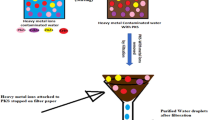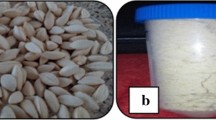Abstract
Heavy metal pollution of water is a serious problem because of its toxic effects on the human health and living organism. Therefore, there is a need to develop technologies to remove toxic pollutants found in polluted water. There are different ways to remove the toxic metals from wastewater. Among all treatments proposed, the adsorption process is one of the most promising technologies in water pollution control. Recently, numerous approaches have been studied for the development of cheaper and effective adsorbents. Many low-cost adsorbents, including natural materials, biosorbents and waste materials from industry and agriculture, have been proposed by several researchers. In this study, removal of copper from aqueous solution by using powdered and modified kernel of date (Fructus dactylus) with apocarbonic anhydrase enzyme has been investigated. The operating variables studied were contact time, initial solution pH, initial metal concentration, temperature and adsorbent dosage. The experimental investigation results showed that modified and powdered kernel of date (F. dactylus) has a high level of adsorption capacity for copper ions. The adsorption data were correlated with the Langmuir and Freundlich isotherm models. It was found that the Langmuir and Freundlich isotherms fitted well to the data. The results revealed that copper is considerably adsorbed on modified and powdered kernel of date (F. dactylus). Consequently, it is concluded that the modified and powdered kernel of date (F. dactylus) can be successfully used for the removal of the copper ions from the aqueous solutions.







Similar content being viewed by others
References
Ahmaruzzaman M, Sharma DK (2005) Adsorption of phenols from wastewater. J Colloid Interface Sci 287(1):14–24
Aksu Z, Isoglu IA (2005) Removal of copper (II) ions from aqueous solution by biosorption onto agricultural waste sugar beet pulp. Process Biochem 40:3031–3044
Aman T, Kazi AA, Sabri MU, Bano Q (2008) Potato peels as solid waste for the removal of heavy metal copper (II) from waste water/industrial effluent. Colloid Surf B 63:116–121
Aravindhan R, Rao JR, Nair BU (2009) Application of a chemically modified green macro alga as a biosorbent for phenol removal. J Environ Manag 90:1877–1883
Arslan O, Nalbantoglu B, Demir N, Ozdemir H, Kufrevioglu OI (1996) A new method for the purification of carbonic anhydrase isozymes by affinity chromatography. Turk J Med Sci 26:163–166
Bable S, Kurniawan TA (2003) Low-cost adsorbent for heavy metals uptake from contaminated water: a review. J Hazard Mater 97:219–243
Bailey SE, Olin TI, Bricka M, Adrian D (1999) A review of potentially low-cost sorbents for heavy metals. Water Res 33:2469–2479
Baraka A, Hall PJ, Heslop MJ (2007) Preparation and characterization of amine–formaldehyde-DTPA chelating resin and its use as an adsorbent for heavy metals removal from wastewater. React Funct Polym 67:585–600
Barsberg S, Sanadi AR, Jorgensen H (2011) A new density functional theory (DFT) based method for supporting the assignment of vibrational signatures of mannan and cellulose-analysis of palm kernel cake hydrolysis by ATR-FT-IR spectroscopy as a case study. Carbohyd Polym 85(2):457–464
Bong KP, Seung HS, Young JY (2004) Selective biosorption of mixed heavy metal ions using polysaccharides. Korean J Chem Eng 21(6):1168–1172
Celebi N, Nadaroglu H, Kalkan H (2012) Removal of As (III) from wastewater using Erzurum clay soil. Fresen Environ Bull 18(5):647–652
Chakravarty S, Pimple S, Chaturvedi HT, Singh S, Gupta KK (2008) Removal of copper from aqueous solution using newspaper pulp as an adsorbent. J Hazard Mat 159:396–403
Dakiky M, Khamis M, Manassra A, Mer’eb M (2002) Selective adsorption of chromium (VI) in industrial wastewater using low-cost abundantly available adsorbents. Adv Environ Res 6(4):533–540
Das J, Patra BS, Baliarsingh N, Parida KM (2006) Adsorption of phosphate by layered double hydroxides in aqueous solutions. Appl Clay Sci 32:252–260
Demir N, Demir Y, Nadaroglu H (2001a) Carbonic anhydrase from bovine bone. Prep Biochem Biotechnol 31(1):33–47
Demir Y, Demir N, Yıldırım S, Nadaroglu H, Karaosmanoglu M, Bakan E (2001b) The activities of carbonic anhydrase and alkaline phosphatase in ancient human bones. Purification and characterization of outer peripheral, cytosolic, inner peripheral, and integral. Prep Biochem Biotechnol 31(3):291–304
Demir Y, Nadaroglu H, Demir N (2007) Purification of carbonic anhydrase from elephas north-east anatolia Elephas trogontherii (Steppe elephant) bone and investigation some properties. Indian J Biochem Biophys 44(3):252–256
Demir N, Nadaroglu H, Demir Y (2009) Carbonic anhydrase from potato (Solanum tuberosum) roots and leaves. Asian J Chem 21(7):5104–5116
El-Said AG, Badawy NA, Garamon SE (2010) Adsorption of cadmium (II) and mercury (II) onto natural adsorbent rice husk ash (RHA) from aqueous solutions: study in single and binary system. J Am Sci 6(12):400–409
Freundlich H, Hatfield H (1926) Colloid and capillary chemistry. Methuen and Co., Ltd., London
Ghazy SE, Ragab AH (2007) Removal of copper from water samples by sorption onto powdered limestone. Indian J Chem Technol 14(5):507–514
Gupta VK, Ali I (2004) Removal of lead and chromium from wastewater using bagasse fly ash - a sugar industry waste. J Colloid Interface Sci 271:321–328
Gupta VK, Rastogi A (2008) Sorption and desorption studies of chromium (VI) from nonviable cyanobacterium Nostoc muscorum biomass. J Hazard Mater 154:347–354
Gupta VK, Mittal A, Gajbe V, Mittal J (2006) Removal and recovery of the hazardous azo dye acid orange 7 through adsorption over waste materials: bottom ash and de-oiled soya. Ind Eng Chem Res 45:1446–1453
Gupta VK, Gupta B, Rastogi A, Agarwal S, Nayak A (2011) A comparative investigation on adsorption performances of mesoporous activated carbon prepared from waste rubber tire and activated carbon for a hazardous azo dye—Acid Blue 113. J Hazard Mater 186(1):891–901
Habib A, Islam N, Islam A, Alam AMS (2007) Removal of copper from aqueous solution using orange peel, saw dust and bagasse. Pak J Anal Environ Chem 8(1–2):21–25
Jayakumar R, Menon D, Manzoor K, Nair SV, Tamura H (2010) Biomedical applications of chitin and chitosan based nanomaterials—A short review. Carbohyd Polym 82(2):227–232
Jiang Y, Pang H, Liao B (2008) Removal of copper (II) ions from aqueous solution by modified bagasse. J Hazard Mater 164:1–9
Kalavathy MH, Miranda LR (2010) Comparison of copper adsorption from aqueous solution using modified and unmodified Hevea brasiliensis saw dust. Desalination 255:165–174
Kalkan E, Nadaroglu H, Demir N (2012) Experimental study on the nickel (II) removal from aqueous solutions using silica fume with/without apocarbonic anhydrase. Desalin Water Treat 44(1–3):180–189
Kannan KK, Liljas A, Lundin J, Strandberg B, Strandberg B, Tilander B, Wirén G (1967) Crystal structure of human erythrocyte carbonic anhydrase C.3. Molecular structure of enzyme and of one enzyme-inhibitor complex at 5.5 Å resolution. J Mol Biol 25:505–516
Kaonga CC, Kumwenda J, Mapoma HT (2010) Accumulation of lead, cadmium, manganese, copper and zinc by sludge worms; Tubifex tubifexin sewage sludge. Int J Environ Sci Technol 7(1):119–126
Kara Y (2005) Bioaccumulation of Cu, Zn and Ni from the wastewater by treated Nasturtium officinale Int. J Environ Sci Technol 2(1):63–67
Karbassi AR, Nouri J, Ayaz GO (2007) Flocculation of trace metals during mixing of Talar river water with Caspian Seawater. Int J Environ Res 1(1):66–73
Kumar PS, Ramakrishnan K, Gayathri R (2010) Removal of nickel (II) from aqueous solutions by ceralite IR 120 cationic exchange resins. J Eng Sci Technol 5:232–243
Langmuir I (1918) The adsorption of gases on plane surfaces of glass, mica and platinum. J Am Chem Soc 40(8):1361–1403
Li X, Li Y, Ye Z (2011) Preparation of macroporous bead adsorbents based on poly(vinyl alcohol)/chitosan and their adsorption properties for heavy metals from aqueous solution. Chem Eng J 178:60–68
Liljas A, Kannan KK, Bergstén PC, Waara I, Fridborg K, Strandberg B, Carlbom U, Järup L, Lövgren S, Petef M (1972) Crystalstructure of human carbonic anhydrase C. Nat New Biol 235:131–137
McKay G, Otterburn MS, Sweeney AG (1980) The removal of colour from effluent using various adsorbents. III Silica: rate processes. Water Res 14:15–20
Mukhopadhyay M, Noronha SB, Suraishkumar GK (2007) Kinetic modeling for the bioadsorption of copper by pretreated Aspergillus niger biomass. Bioresour Technol 98:1781–1787
Nadaroglu H, Kalkan E (2012) Removal of cobalt (II) ions from aqueous solution by using alternative adsorbent industrial red mud waste material. Int J Phys Sci 7(9):1386–1394
Nadaroglu H, Kalkan E, Demir N (2010) Removal of copper from aqueous solution using red mud. Desalination 153(1–3):90–95
Nadaroğlu H, Demir N, Demir Y (2008) An enzymatic method for zinc determination in milk and dairy products. Asian J Chem 20(2):1497–1502
Nollet H, Roels M, Lutgen P, Van Der Meeren P, Verstraete W (2003) Removal of PCBs from wastewater using fly ash. Chemosphere 53:655–665
Ong SA, Lim PE, Seng CE (2003) Effects of adsorbents and copper(II) on activated sludge microorganisms and sequencing batch reactor treatment process. J Hazard Mater B 103:263–277
Onundi YB, Mamun AA, Al Khatib MF, Ahmed YM (2010) Adsorption of copper, nickel and lead ions from synthetic semiconductor industrial wastewater by palm shell activated carbon. Int J Sci Technol 7(4):751–758
Pollard SJT, Fowler GD, Sollars CJ, Perry R (1992) Low cost adsorbents for waste and wastewater treatment: A review. Sci Total Environ 116:31–52
Pons MP, Fuste CM (1993) Uranium uptake by immobilized cells of Pseudomonas strain EPS 5028. Appl Microbiol Biotechnol 39(4–5):661–665
Pronczuk J, Brune MN, Gore F (2011) Children’s environmental health in developing countries. Encyclopedia of Environmental Health, pp. 601–610
Rao MM, Ready DDKK, Venkateswarl P, Seshaiah K (2008) Removal of mercury from aqueous solution using activated carbon prepared from agriculture by-product/waste. J Environ Manag 90(1):634–643
Resmi G, Thampi SG, Chandrakaran S (2010) Brevundimonas vesicularis check for this species in other resources: a novel bio-sorbent for removal of lead from wastewater. Int J Environ Res 4(2):281–288
Seifullina II, Skorokhod LS (1991) Spectrophotometric study of the reaction of copper (II), nickel (II) and cobalt (II) salts with 1-amino-2-hydroxy-4-naphthalenesulfonic acid. Russ J Gen Chem (Zhurnal Obshchei Khimii) 61:2005–2008
Sekher KC, Subramanian S, Modak JM, Natarajan KA (1988) Removal of metal ions using an industrial biomass with reference to environmental control. Int J Miner Process 53:107–120
Shetty R, Rajkumar S (2009) Biosorption of Cu (II) by metal resistant Pseudomonas check for this species in other resources sp. Int. J. Environ. Res. 3(1):121–128
Sousa FW, Oliveira AG, Ribeiro JP, Rosa MF, Keukeleire D, Nascimento RF (2010) Green coconut shells applied as adsorbent for removal of toxic metal ions using fixed-bed column technology. J Environ Manag 91:1634–1640
Treybal RE (1980) Mass transfer operations, 3rd edn. McGraw Hill, New York, pp 447–522
Unabia LNL, Zaide RA (2002) Enhanced EDX analysis through effective utilization of electron flight simulator. In: Proceedings of Association of Semiconductors Electronics Manufacturing Engineers of the Philippines (ASEMEP) National Technical Symposium, July 3, 2002, Philippine
Xu Y, Feng L, Jeffrey PD, Shi Y, Morel FMM (2008) Structure and metal exchange in the cadmium carbonic anhydrase of marine diatoms. Nature 452:56–61
Zaki S, Farag S (2010) Isolation and molecular characterization of some copper biosorped strains. Int J Environ Sci Technol 7(3):553–560
Zawani Z, Luqman CA, Choong TSY (2009) Equilibrium, kinetics and thermodynamic studies: adsorption of Remazol Black 5 on the palm kernel shell activated carbon (PKS-AC). Eur J Sci Res 37(1):63–71
Zhou JL, Kiff RJ (1991) The uptake of copper from aqueous solution by immobilized fungal biomass. J Chem Technol Biotechnol 52:317–330
Zvinowanda CM, Okonkwo JO, Shabalala PN, Agyei NM (2009) A novel adsorbent for heavy metal remediation in aqueous environments. Int J Environ Sci Technol 6(3):425–434
Acknowledgments
The laboratory study of this research was carried out in the Laboratories of Erzurum Vocational Training School of Ataturk University. So, the authors thank the authorities.
Author information
Authors and Affiliations
Corresponding author
Rights and permissions
About this article
Cite this article
Nadaroglu, H., Kalkan, E. & Celik, H. Equilibrium studies of copper ion adsorption onto modified kernel of date (Fructus dactylus). Int. J. Environ. Sci. Technol. 12, 2079–2090 (2015). https://doi.org/10.1007/s13762-014-0607-y
Received:
Revised:
Accepted:
Published:
Issue Date:
DOI: https://doi.org/10.1007/s13762-014-0607-y




